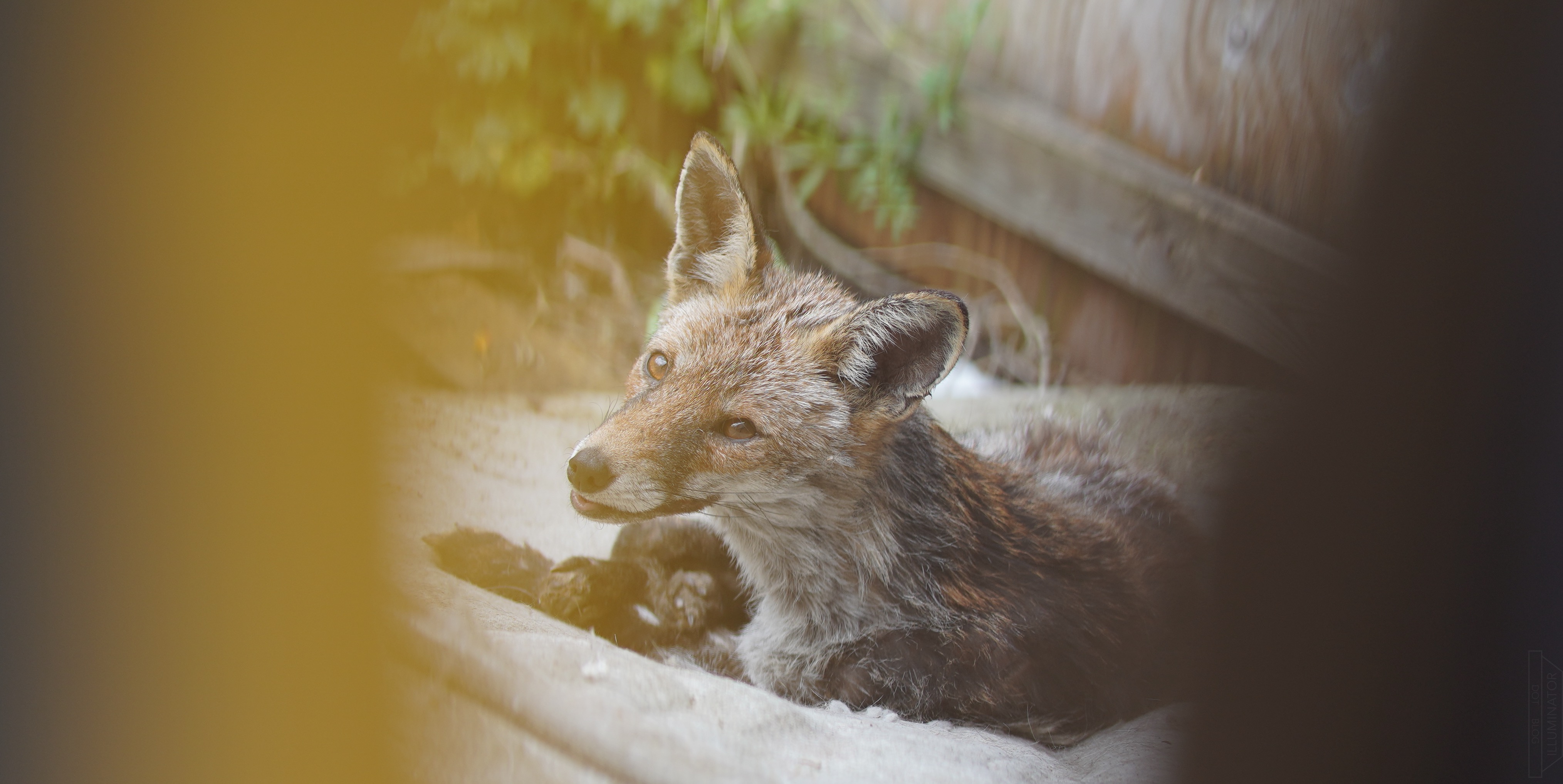
{ Outside the East India Docks. May 25th, 2023. }
Perhaps everyone reading these words will be familiar with The Sir John Franklin pub in Greenhithe, London, the location on the Thames from which Franklin’s ships Erebus and Terror departed in May of 1845, never to return.
This article isn’t about that Sir John Franklin pub. This is about a very different Sir John Franklin pub.
Not long ago, my co-author Alison Freebairn discovered that there was – or rather, that there used to be – another Sir John Franklin pub, also in East London, this one on the north bank of the Thames.
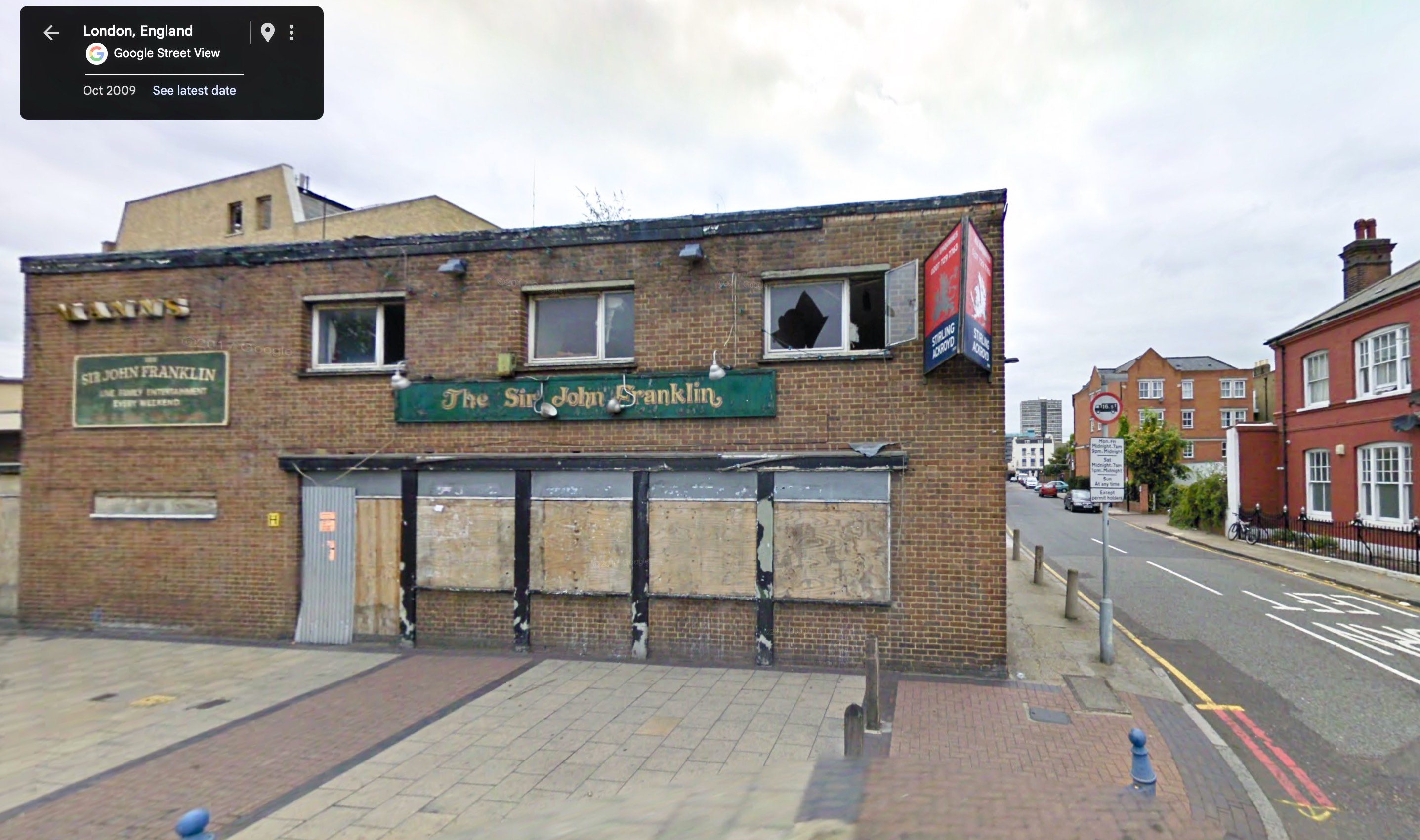
{ Google Street View, from October 2009. }
This Sir John Franklin pub was closed either in 2005 – or 2007 – and was fully torn to the ground in 2011 – or maybe 2012. By the pre-demolition photography, it was clearly a rough modern affair, and not of any historic interest.
Or was it? Something caught our eye that made us wonder. The location of this pub was interesting: this Sir John Franklin pub had been located on East India Dock Road.
The East India Docks... That name was familiar to us. In 2021, we had worked on an article determining where exactly in London that this historic photograph had been taken.
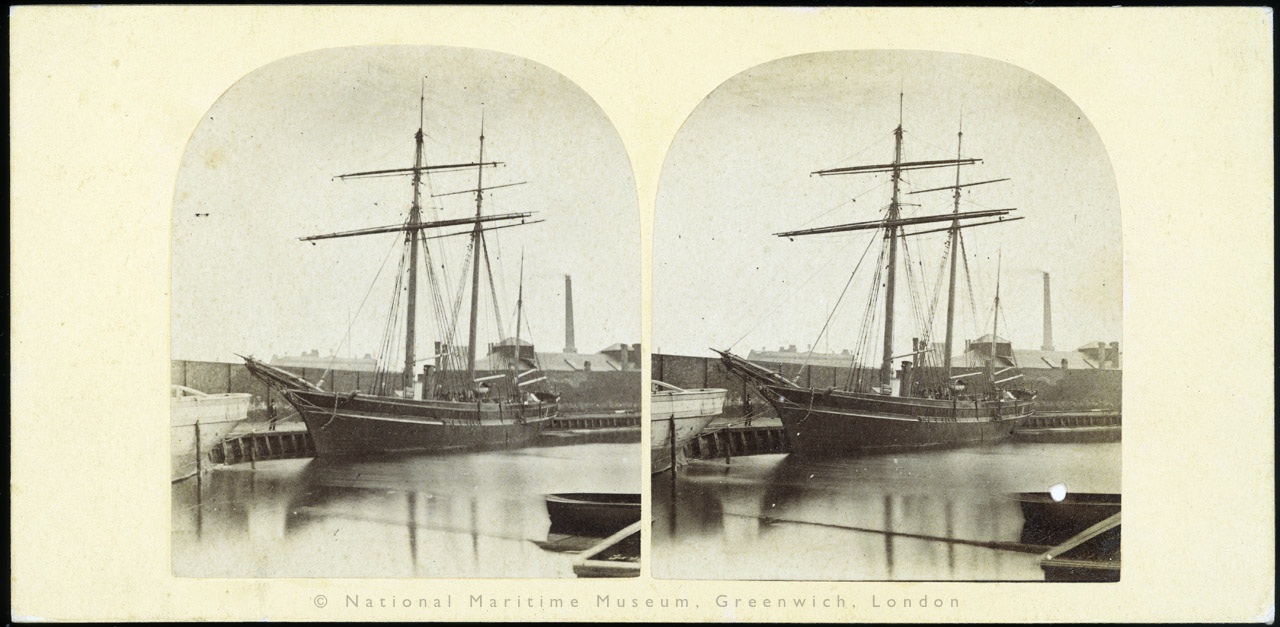
{ The Fox, by John Powles Cheyne. }
The ship pictured was known to be the Fox. After Erebus and Terror, the Fox was the third most important ship in the story of the Franklin Expedition. Purchased by Jane Franklin and captained by Leopold McClintock, this was the ship that in 1859 recovered the Peglar Papers, the relics from the Boat Place, and most notably the Victory Point Record, revealing the date of John Franklin’s death. When the Fox brought these home to London, it effectively ended the British search for Franklin. [To be taken up next, oddly enough, by the Americans.]
And so that is what the (above) photograph shows us: the Fox’s return in 1859, and the end of a nation’s search for their lost countrymen.
While it could have been anywhere in London, or Portsmouth, we determined that where the photograph was taken – where the Fox had returned to – had specifically been London’s East India Docks.
Knowing that, then where exactly on the two miles of East India Dock Road had that rough-looking Sir John Franklin pub been located? How close had it been?
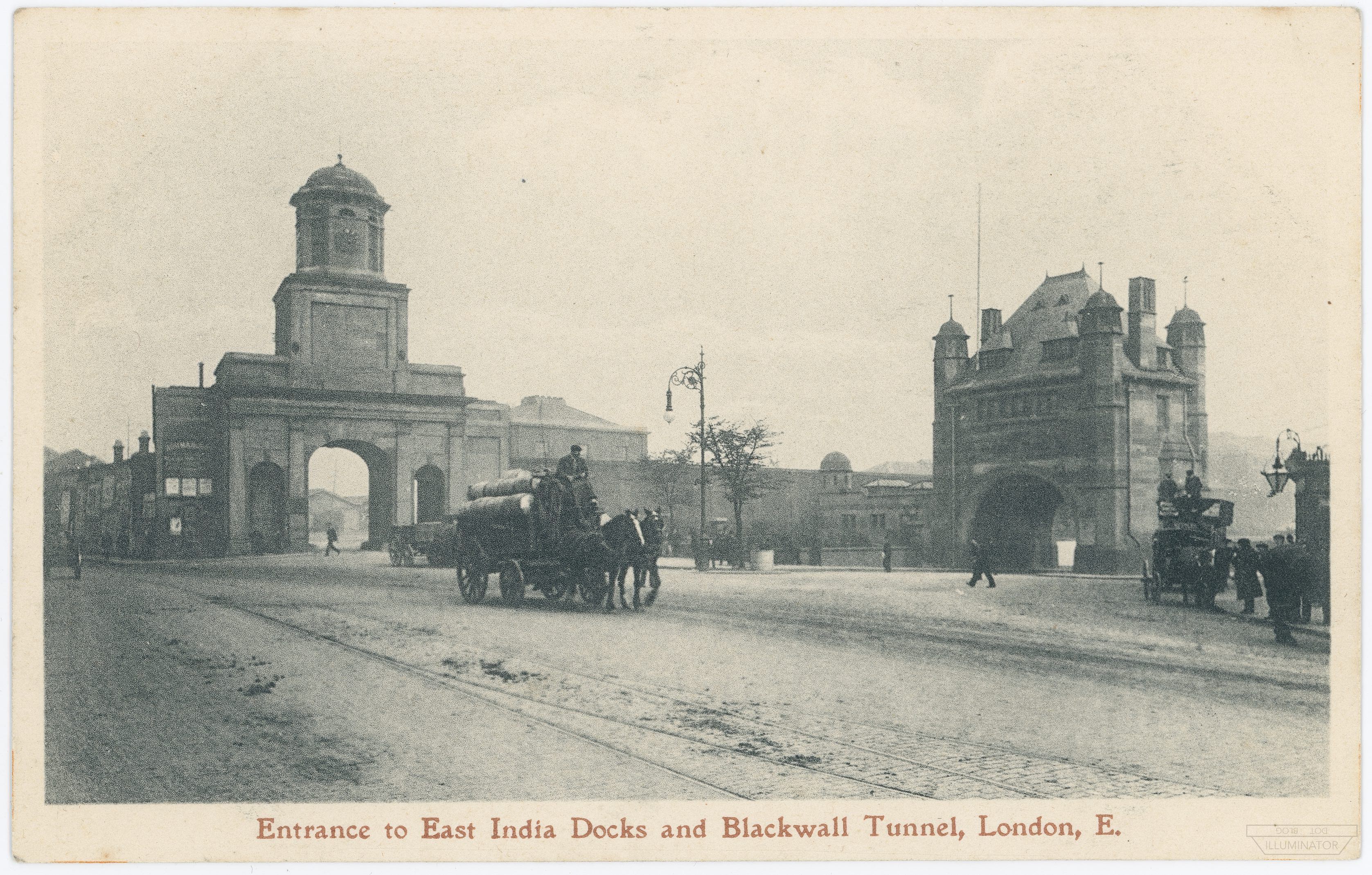
{ Undated photograph of the East India Docks entrance. }
This historic photograph shows the main entrance to the East India Docks (left), and the old entrance to the Blackwall Tunnel. Both edifices are today destroyed. But that modern, shabby Sir John Franklin pub would later be located right here: in this photo, the photographer is practically standing on the front step of where the rough Sir John Franklin pub was demolished just a decade ago. We are seeing what would have been the view out the pub’s front door.
This did not seem like a coincidence. We kept digging, but the initial results were not promising.
As the website Shopfront Elegy succinctly sums up the pub (link): “Unlovely boozer built near Blackwall Tunnel’s hell-mouth in 1963.”
Indeed, The Sir John Franklin seems to have been something of a scratching post for writers seeking out London’s worst pubs.
Dodgy Boozers was a site that described their writing as: “A celebration of a Britain that is slightly shabby, where plastic bags still fly from our trees and there’s a black bag taped over the broken pane in the gents.” Dodgy Boozers made in 2007 what must be the final recorded visit to The Sir John Franklin (a date long after other sites believe the pub had been shuttered). In their crisp two-paragraph autopsy (link), they noted that the sign with the pub’s name was partially snapped off, the glass of the back door was shattered and held together by black tape, the television inside was playing an old black and white romantic movie, and that “A greasy little Yorkshire terrier circles the room occasionally coming up to us inviting a pat.” [Click their link for the full vignette. Pity they didn’t get the name of the dog, though.]
Dodgy Boozers also noted that: “The bar has a small stage in the top corner with a flimsy wooden balustrade.” That stage and balustrade were likely the surviving relics of what had once been The Sir John Franklin’s chief attraction: girls.
The site PigsEar.org.uk preserves the East London & City Beer Guide for 1983 (link), which advertised that on weekday evenings, The Sir John Franklin featured strippers. Paul Talling’s site Derelict London (link) records the reminiscences of the late Bill Martland, who self-published In the Begining There was Theresa, “A personal illustrated history of the London strip pub scene since 1976.” On The Sir John Franklin pub at the East India Docks, Martland wrote:
“I was working for London Docklands Development Corporation in the mid 1980s and given the London traffic when I found out the Sir John Franklin had strippers on early in the evening I used to stop there on the way home most nights. The girls were mainly good, the landlord was a man called Barry who fancied himself as a stand up comic but as a pub operator was useless. Hardly ever was there draft beer, crisps, and change available simultaneously and the bar was always sticky! Despite his uselessness the place stayed reasonably busy but then a subsequent landlord dropped strippers and later though they were brought back it never really took off again. Horrible 50s or 60s building, I don’t know what Franklin (a polar explorer) had done to deserve having a dump like that named after him!”[Link to Derelict London.]
These years were heady times for Franklin: when the Breadalbane shipwreck was found, when photographs of John Torrington made worldwide news, and when Stan Rogers’ “Northwest Passage” was on the radio. During this same cultural resurgence, East London was hosting what may be history’s first and only Sir John Franklin strip pub.
By this era, The Sir John Franklin had turned twenty years old. The East London & City Beer Guide for 1986 had noted that she had been built back in 1963 (link to PigsEar.org.uk).
The site Boak & Bailey’s Beer Blog (link) has found a photo of what The Sir John Franklin had looked like then, when she was spanking new and rather classy. This is the only photo of her interior that we have yet come across.
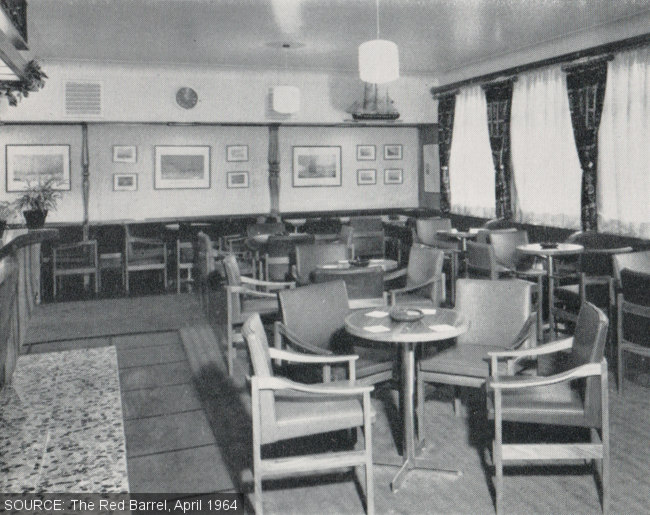
{ The Sir John Franklin pub at the East India Docks. }
{ Image courtesy of Boak & Bailey (link). }
We haven’t been able to identify the three larger prints on the wall. But if the pub had any eye towards historical accuracy, there were of course many excellent coloured prints from the 19th century Franklin searches that they may have chosen. There is a ship model visible near the ceiling, however the bow looks a bit too sharp to be either Erebus or Terror.
Boak & Bailey found this photograph in a 1964 issue of The Red Barrel, an in-house magazine for Watney Mann breweries. [Their article helpfully collects more photographs of other Watney Mann pubs built at the same time, in the same design language as the 1963 Sir John Franklin (link).]
From The Red Barrel magazine, as quoted by Boak & Bailey: “The Sir John Franklin, a new Mann’s house, takes its name from a Mann’s house damaged by bombing during the war.”
This last detail was something we kept finding reference to: that there had once been another, older Sir John Franklin pub on the same site.
At first, all we could find was this photograph from 1956. It shows the old pub in the process of being razed to the ground. She had survived World War 2, only to be sacrificed to accommodate modern automobile traffic through the Blackwall Tunnel.
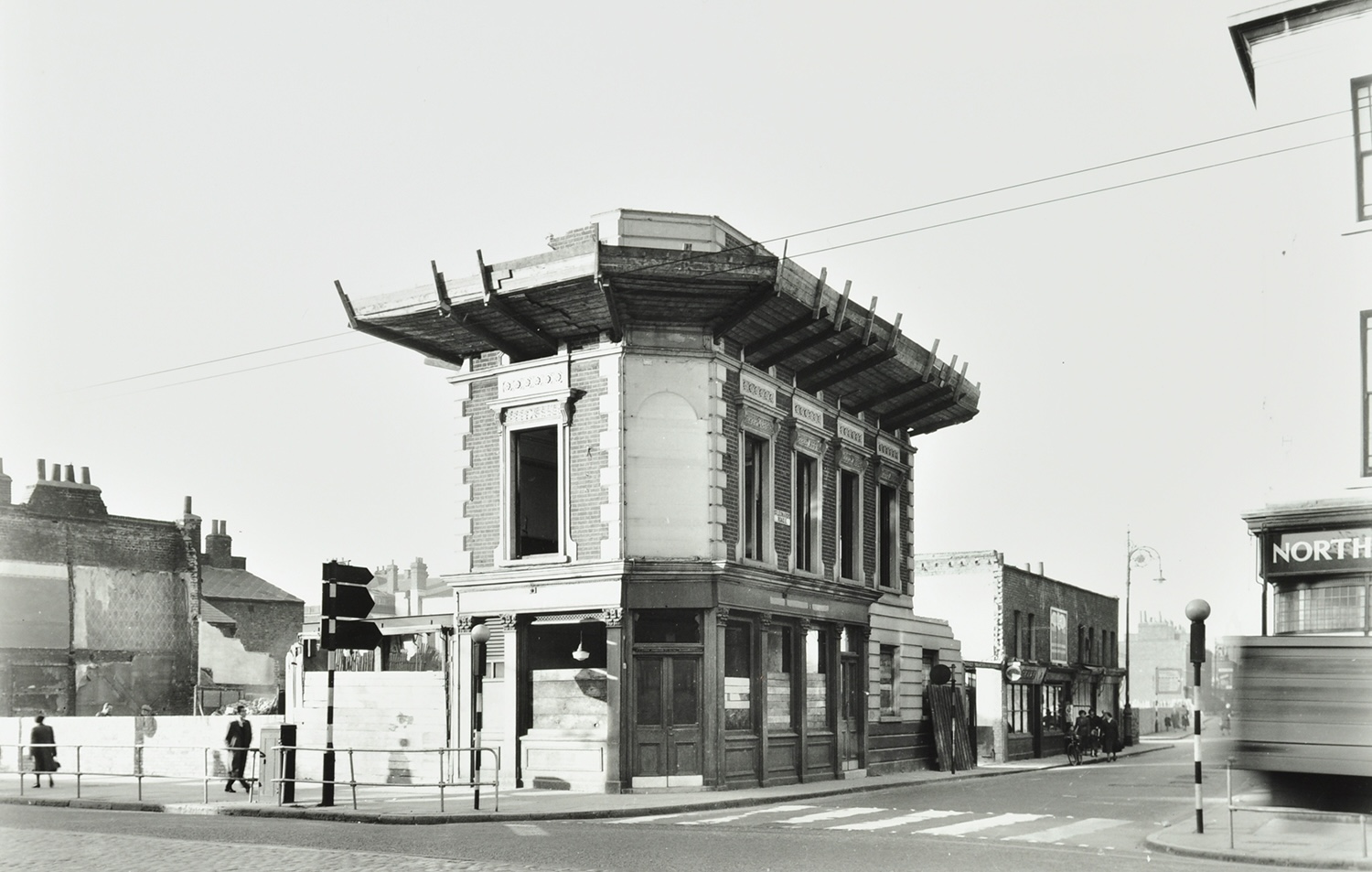
{ The old Sir John Franklin pub at the East India Docks. }
{ The London Archives (City of London Corporation). }
This photograph comes from the massive London Picture Archive. We didn’t need to identify for ourselves where the photo was taken, as the archive knew what intersection this was, and even knew that this wrecked and boarded up building had been the old, previous Sir John Franklin pub.
But here in 2023, we had to set this story aside. With only the image above, we couldn’t complete this article.
Now in 2025, that same London Picture Archive has since found another photograph of the pub. It was taken in 1955, just one year before the previous photo. Here we are able to see what the old Sir John Franklin pub looked like when they were still pouring ale at the bar — Mann’s Brown Ale, according to the sign.
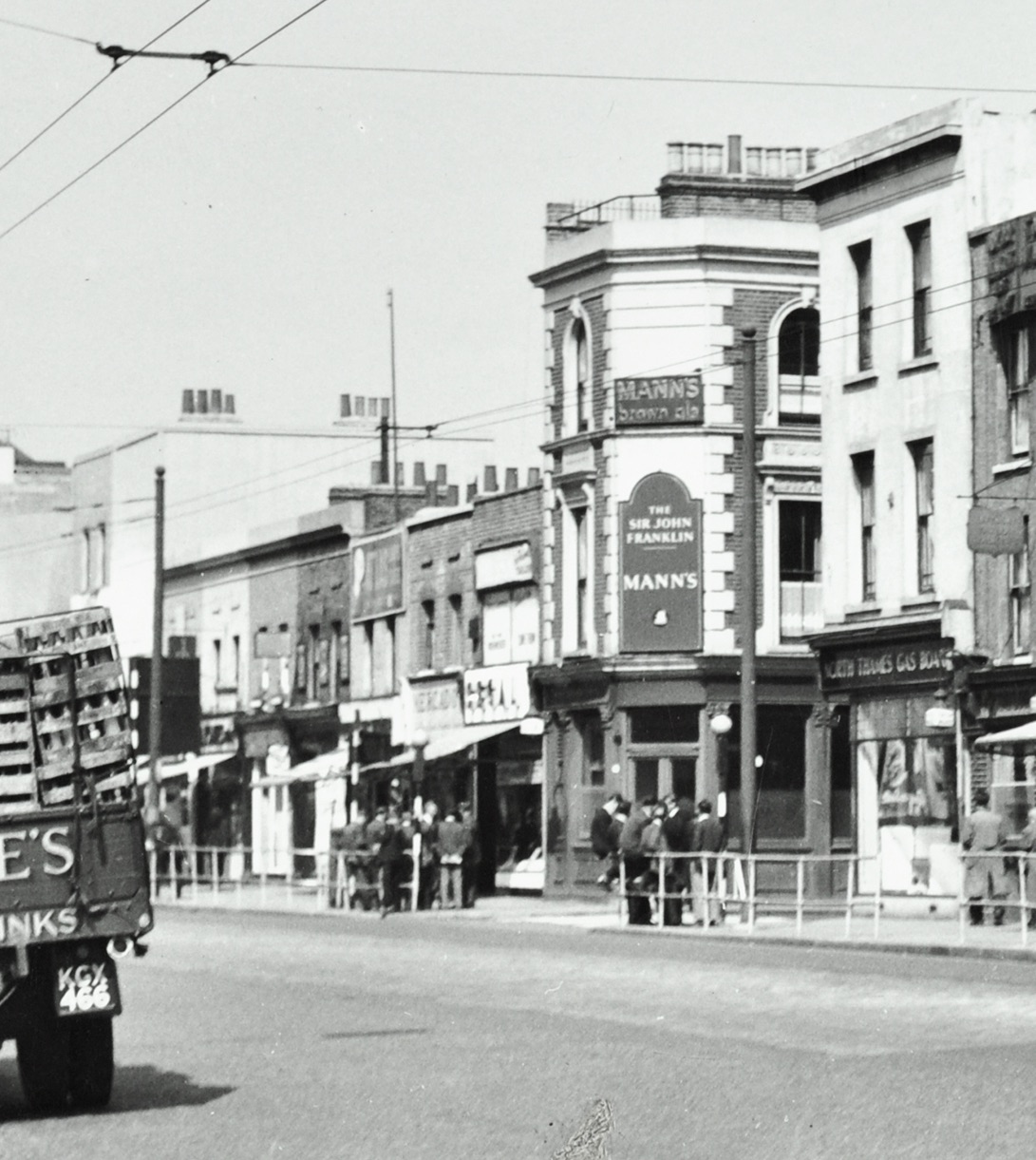
{ The Sir John Franklin pub at the East India Docks. }
{ The London Archives (City of London Corporation). }
This old three-storey Victorian building on East India Dock Road had in fact been The Sir John Franklin pub for almost 100 years. One wonders if Franklin historian Richard J. Cyriax ever stopped in for a pint, to scribble a few notes toward his 1939 classic history of the expedition (the copies of which, like this pub, would be partially damaged by fascist bombs). The decades of accumulated Franklin-iana inside must have been extraordinary. Doubtlessly they had handsome portraits of Sir John on the walls, a model of his ship HMS Erebus, and a framed copy of the Victory Point Record, the one that had been published in The Illustrated London News in 1859.
Indeed, the pub might as well have been named The Victory Point Record. For the most interesting fact about this pub is its birthdate: it was erected in 1859 — the same year that the Fox arrived here at the East India Docks. Construction bids were published in January 1859 for a Mr. Francis Rogers (The Building News), while the Fox was still in the Arctic, with no mention of a public house nor the name Franklin yet attached. Then, just a few years later, a story appears in January 1863 about that same Francis Rogers having his watch stolen, and it describes him as “of the Sir John Franklin” on East India Dock Road (Evening Standard). [The court reporter noted the room laughing as a watchmaker testified that the stolen watch was worth less for being, “knocked about by Mr. Rogers amongst the butts (casks) in his cellar.”]
What a pity that the old pub’s proximity to the East India Dock’s entrance – and specifically the Blackwall Tunnel – would be its undoing. Given the foundation date of 1859, the pub’s location at the entrance to the East India Docks, and the name “Sir John Franklin” appearing so close in time to the Fox’s sensational homecoming, this pub had memorialized where the British search for Franklin ended.
Had it survived, it would have been possible today to visit The Sir John Franklin pub where the story began, at Greenhithe in 1845, and then travel across the Thames, to visit The Sir John Franklin pub where the story ended, at the East India Docks in 1859.
Instead, this is now a thoroughly destroyed site on the London-Franklin tour itinerary. Alison and I paid a visit in the summer of 2023, to see what was left of the wreck of The Sir John Franklin.
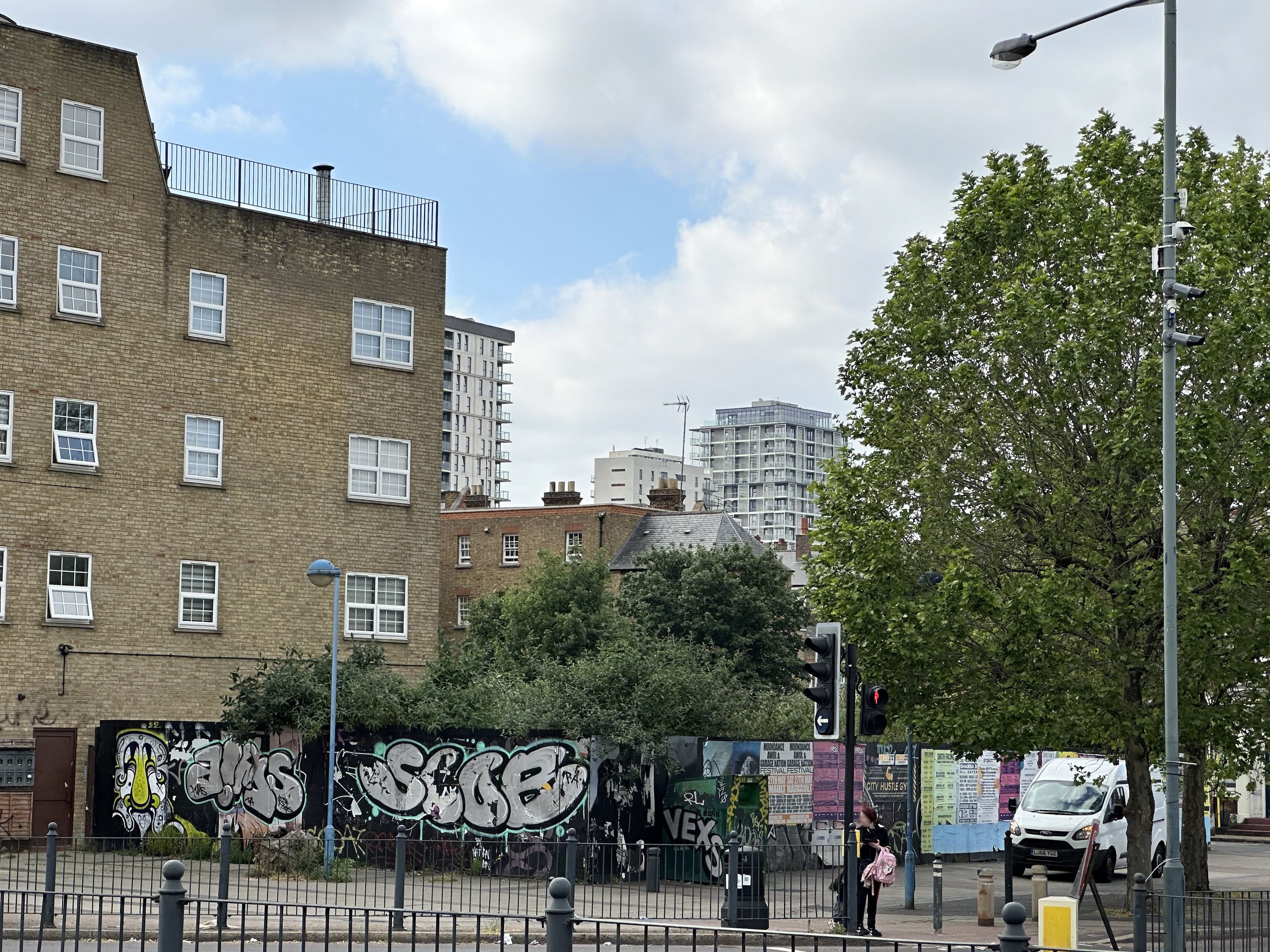
{ The wreck of The Sir John Franklin. May 25th, 2023. }
The black walls that cordoned off the pub’s demolition site are still standing, covered in geological layers of graffiti and posters. The walls have been up for so many years that a private grove of trees has grown up inside them.
Around back, everything was firmly closed. But a slim crack in the walls revealed that the site is still inhabited. The last proprietor of The Sir John Franklin pub on East India Dock Road is – quite appropriately, given the reason that this site was historically significant – a fox.
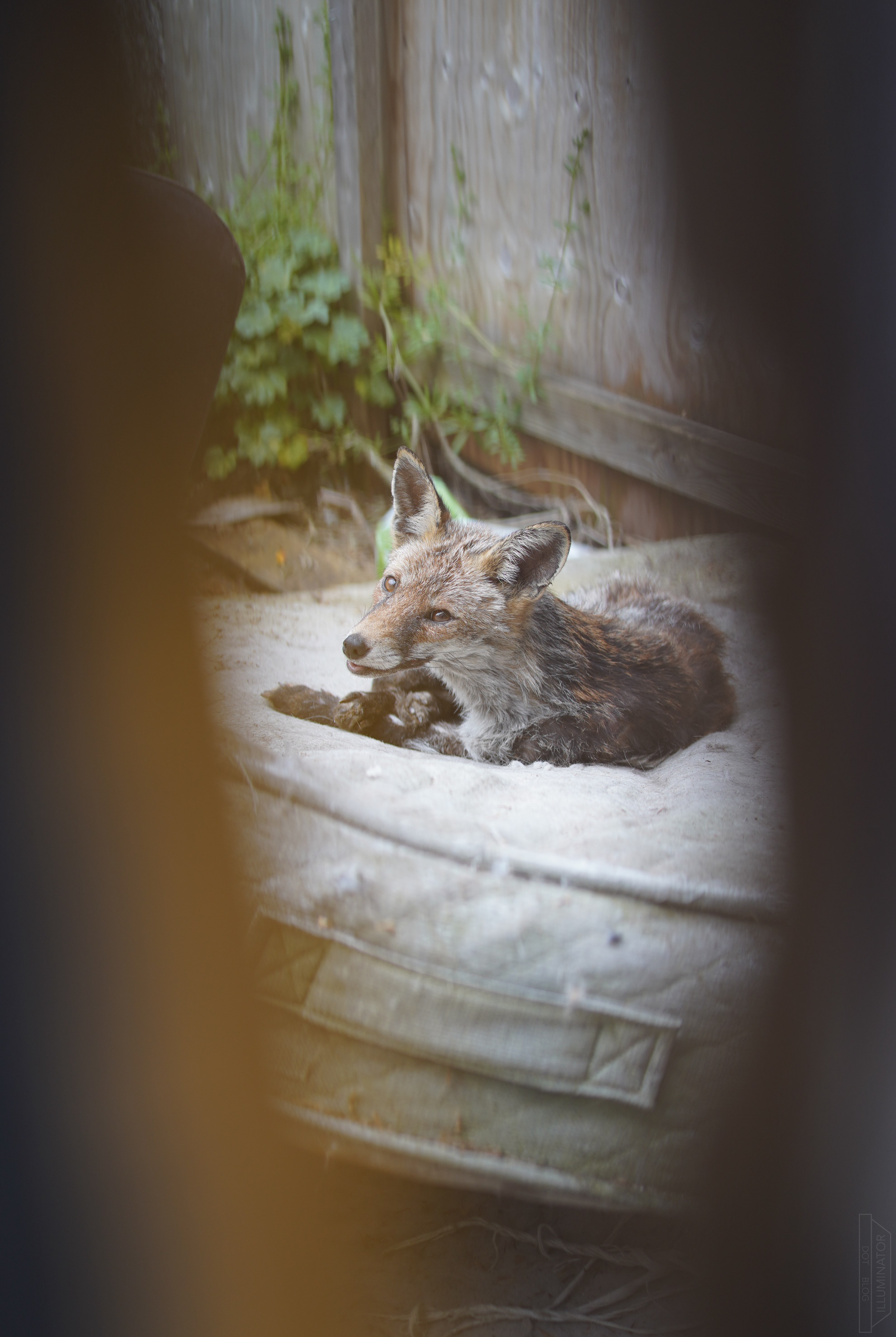
{ Under new management: inside the wreck site, 25th May 2023. }
* * *
To our surprise, as we began pulling on this string, we found that there had once been a constellation of Franklin Expedition pubs across London.
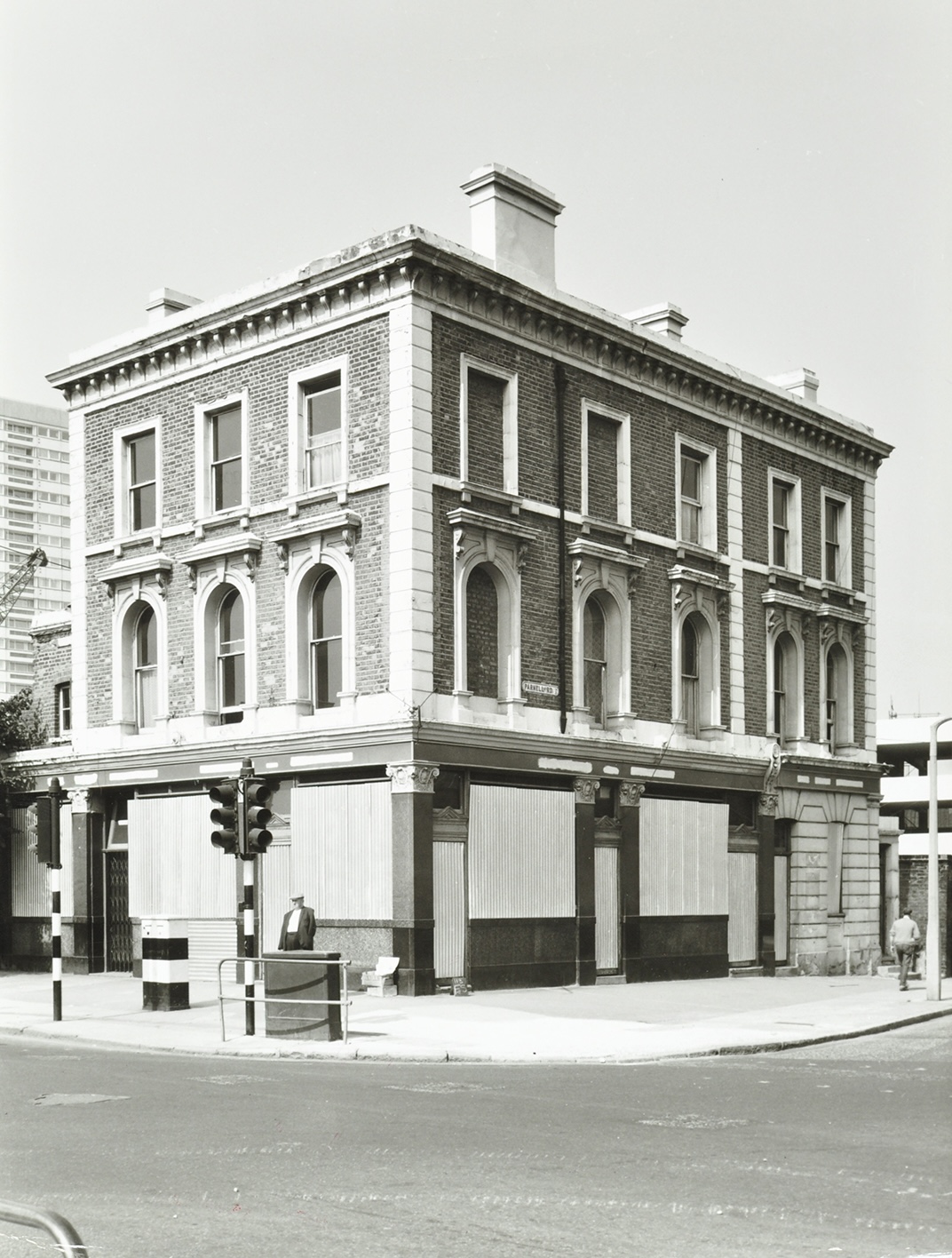
{ The closed Lady Franklin pub on Old Ford Road. }
{ The London Archives (City of London Corporation). }
Just two miles north of The Sir John Franklin, there was a Lady Franklin pub, seen here shortly after closure in this 1970 photograph. This Lady Franklin apparently existed from at least 1861 — a surprisingly early date, given that the real Jane was alive until 1875. [The building is no longer there.]
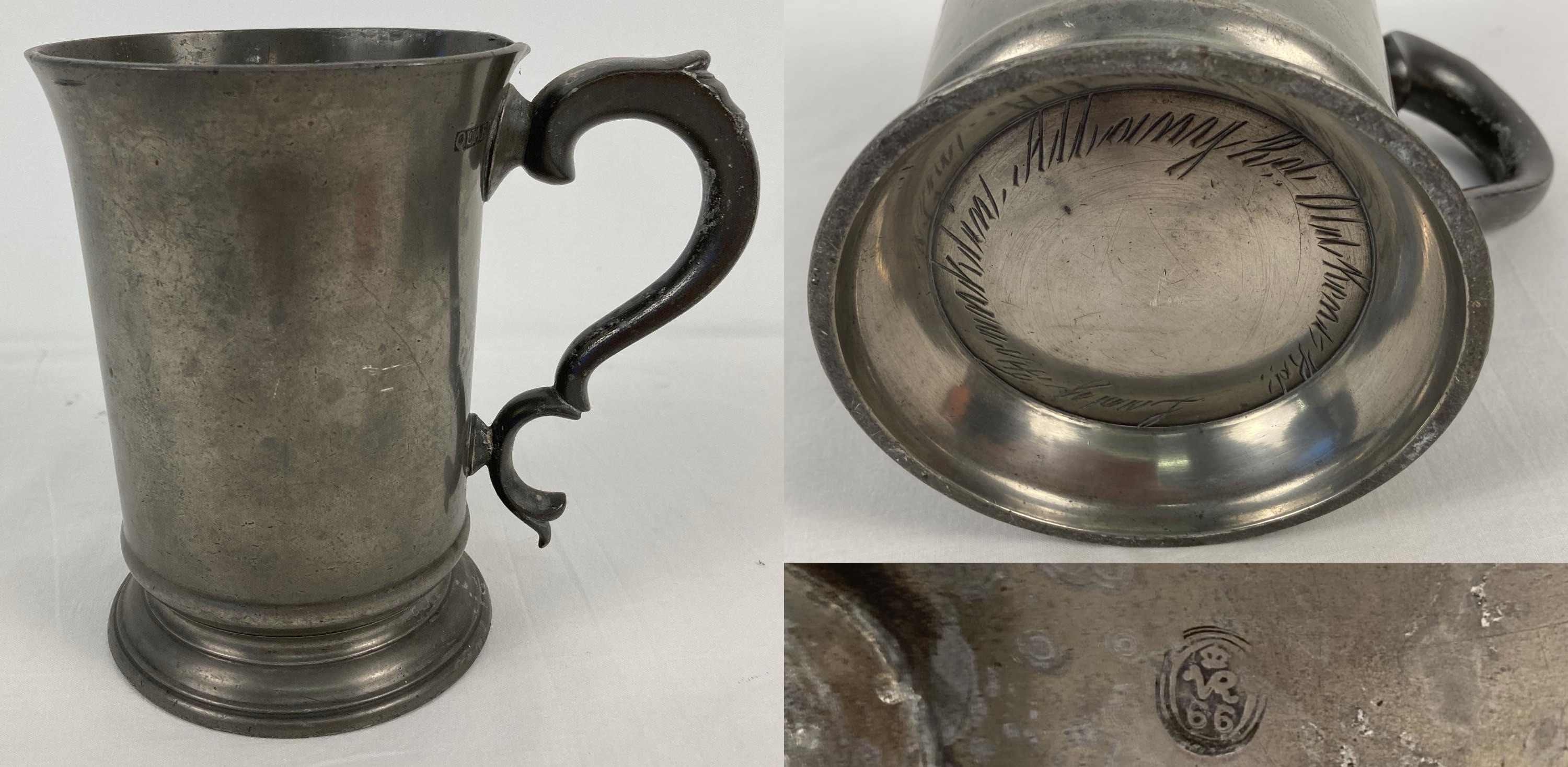
{ Tankard marked Lady Franklin (Beeston Auctions of Norfolk). }
In 2021, Alison saw this pewter tankard at auction. Across the bottom, it says “Lady Franklin, Albany Rd, Old Kent Rd”, with a mark “VR 66” (said by the auction house to signify the year 1866).
And yet this was from another, different Lady Franklin pub. Those directions underneath – saying in essence, “take Albany Road off Old Kent Road” – led to a pub located south of the Thames, much closer to the city’s center. The pub was noted by Barbara Rich in a 2020 article, where Rich found the sisters of the Erebus’s Edward Couch living on that same Albany Road (link). This Lady Franklin pub was apparently exploded by a V2 rocket during World War 2.
As to her husband, there were also more Sir John Franklin pubs around London: one in Shoreditch, and another in Limehouse. The latter was located right on the Thames – the brick building is still there – just a mile from The Sir John Franklin pub at the East India Docks.
In fact, if one had organized a pub crawl between these two Sir John Franklin pubs, there would have been additional stops along the way. In the mile between the East India Docks and the Limehouse Sir John Franklins, there stood both a Resolute pub and an Enterprise pub. These survived up until quite recently, within our lifetimes. All are shuttered today, but this chain of East London Franklin pubs very nearly lived to see the rediscovery of HMS Erebus.
Granted, some doubt is naturally raised at the name “Enterprise.” There have been so many ships sharing that name. How could one be certain that a lost Enterprise pub had been dedicated specifically to the Enterprise that searched for Franklin? [Or even for Enterprise the whaler: the ship that (along with the pun-laden whaler the Prince of Wales) was the last to see Franklin’s ships before he disappeared into the Passage?]

{ The Enterprise pub, 1990. Photograph by Peter Marshall (link). }
The pub’s sign had the answer. Above the lost Enterprise pub, its corner street sign depicted a ship iced in for the winter, with a canvas tent covering her deck. This pub had been physically very close to the Limehouse Sir John Franklin pub, and perhaps that is why they made their Enterprise the one that had searched for Franklin.
Given the popularity of that name, there are of course several other Enterprise pubs still dotted around London today (and more that have been shuttered).
Just like the lost Enterprise above, we have found that one of these surviving Enterprise pubs also depicts an Arctic scene on its sign.
The pub is in Holborn, on Red Lion Street (not far from Bedford Place where Jane Franklin lived). After a day of research at the nearby Wellcome Library in June 2025, Alison visited this Enterprise pub, to sample a brew and investigate which Enterprise exactly was depicted on the pub’s sign.
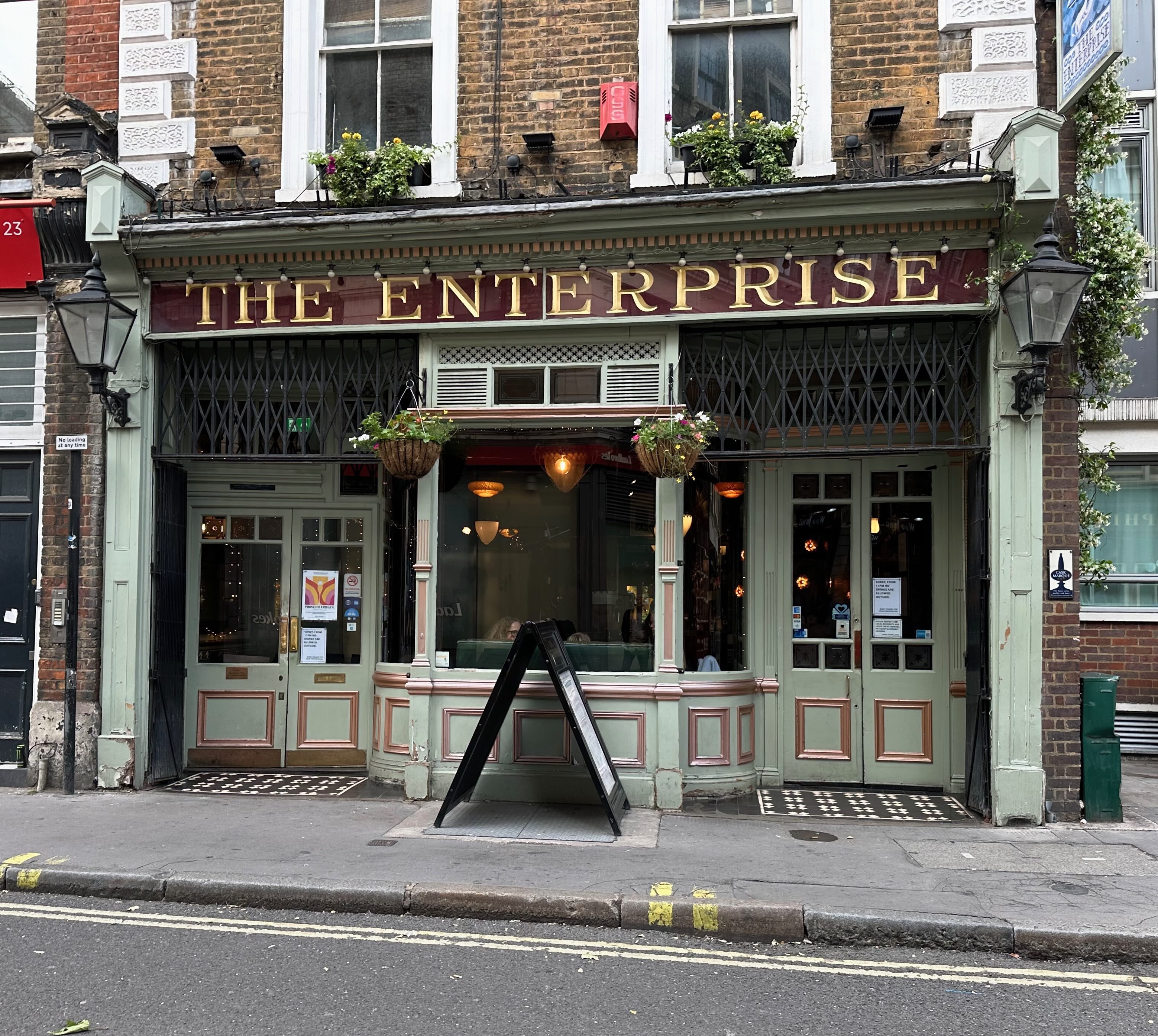
{ The Enterprise pub. Photograph by Alison Freebairn. }
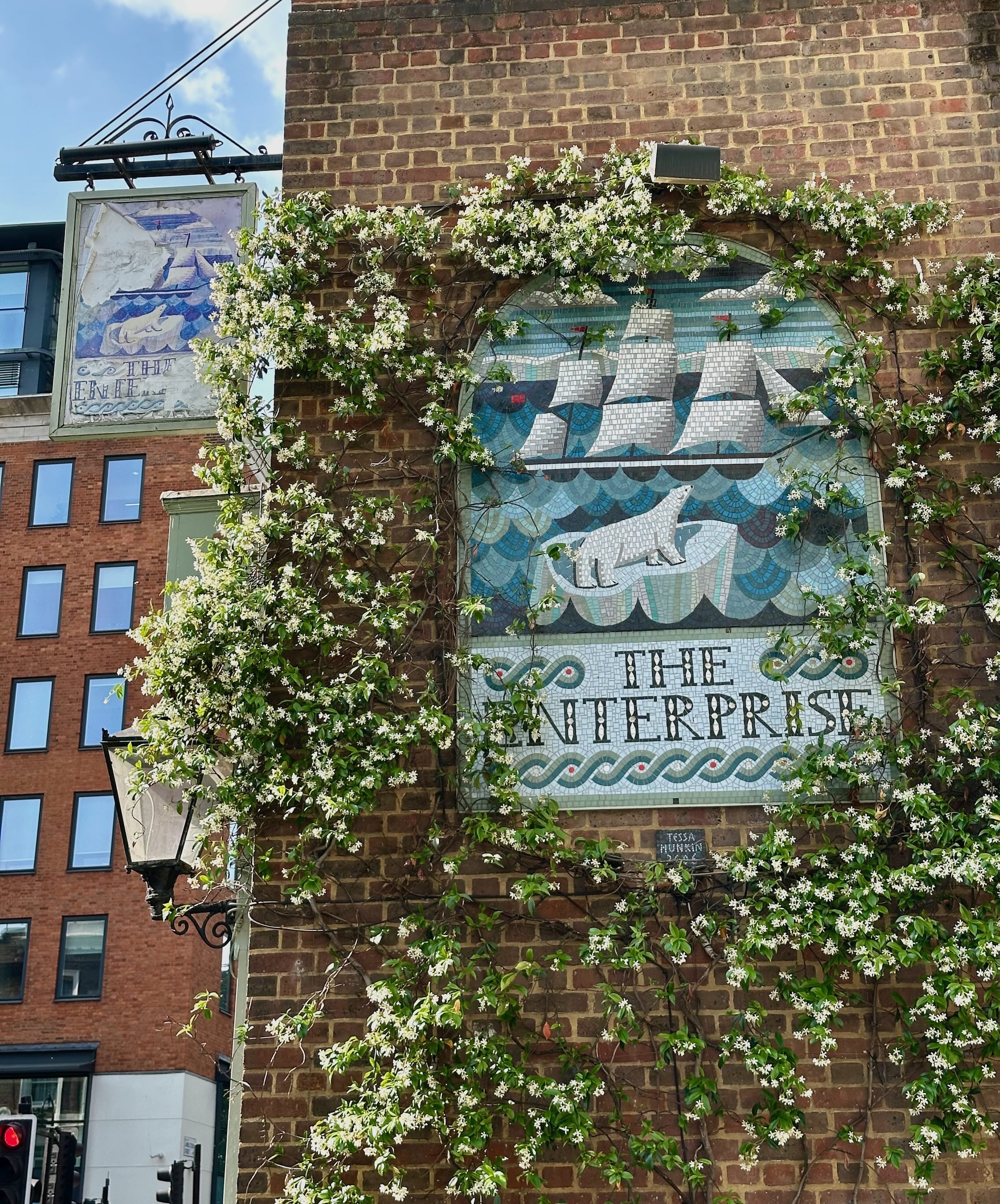
{ The Enterprise pub’s mosaic sign. Photograph by Alison Freebairn. }
At first blush, having a ship named Enterprise sailing in icy waters while being eyed by a polar bear is a strong signal that this pub’s Enterprise must be the one that searched for Franklin.
But with so many ships sharing this name, one would have to do a significant research project to determine if any of history’s other Enterprises ever sailed far enough north to see icebergs and a polar bear, even if only briefly.
When Alison photographed the mosaic, she noticed that at the bottom it said, “Tessa Hunkin 2006.” Reaching out to this artist – almost twenty years after she created the mosaic – we enquired: Why had she chosen to depict this particular scene?
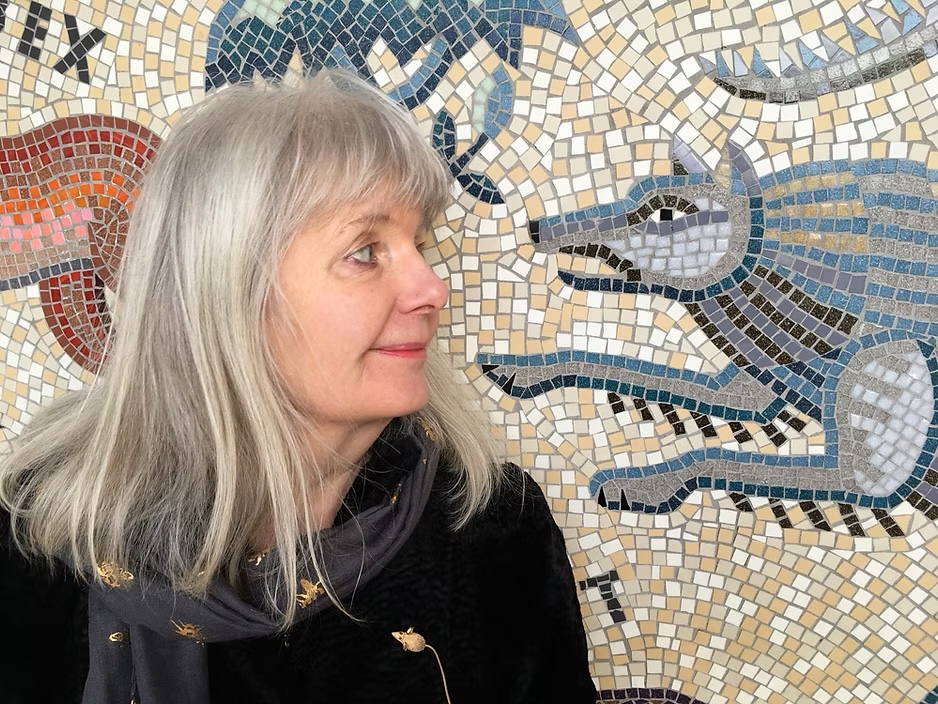
{ Tessa Hunkin with a wolf. }
Tessa wrote back to us that The Enterprise on Red Lion Street had been her local pub in those years, as her mosaic studio had then been located around the corner. She said that she wished to depict this particular scene because she had just read the book Barrow’s Boys by Fergus Fleming, and was fascinated with the Franklin story.
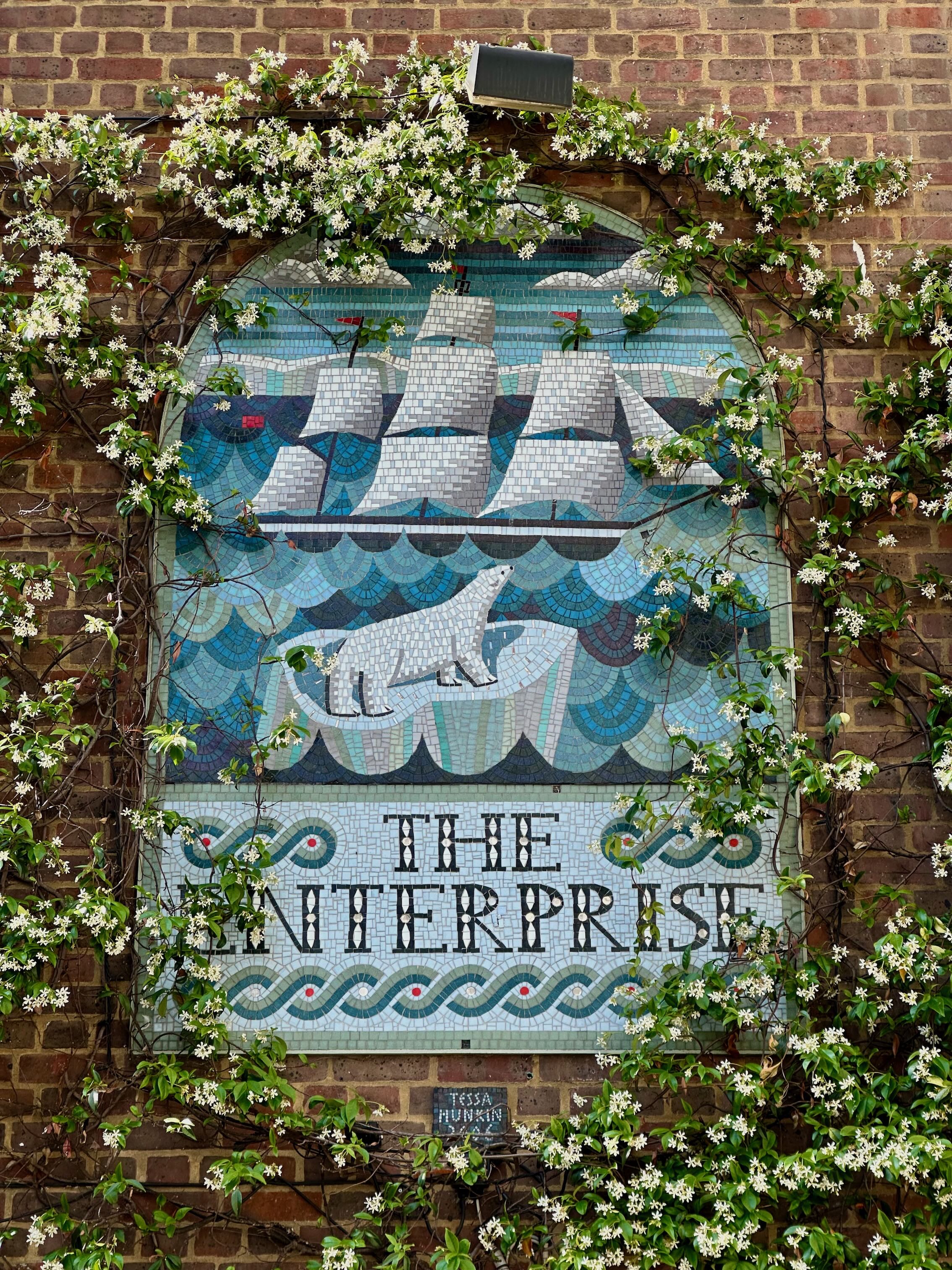
{ Tessa Hunkin’s Enterprise mosaic. Photo by Alison Freebairn. }
Thus, The Enterprise on Red Lion Street – once known as The Grapes – is today not only connected by its name to the Enterprise that searched for Franklin: by its mosaic, it is also tied to a specific Franklin history book, one that all of us have on our bookshelves.
As such, The Enterprise on Red Lion Street joins The Sir John Franklin in Greenhithe as effectively the only Franklin Expedition pubs surviving in London today.
Alison and I have added a note about The Enterprise pub – and the wreck of The Sir John Franklin pub at the East India Docks – to our Franklin Expedition guide to London (link).
The End.
– L.Z. & A.F. July 15, 2025.
Special thanks to Tessa Hunkin for sharing the meaning behind the Enterprise mosaic. She also noted to us that the red flags in the mosaic are part of a geo-cache puzzle in the area. The photograph of Tessa and the wolf was used here with her permission.
Thanks also to Olga Kimmins for archive and photography assistance in London. Thanks to Alex Cross for her photograph of Alexander McDonald in The Richard The First pub. Thanks to Peter Chrisp for use of the photograph of his Franklin door artwork. Thanks to Boak & Bailey for finding the rare photograph of The Sir John Franklin’s interior.
* * *
Appendix 1: Additional notes.
The Enterprise on Red Lion Street also maintains a webpage about their pub’s appearances in film and television, worth a gander before visiting (link).
Regarding Franklin pubs in London, an honorable mention should be made for The Trafalgar in Greenwich. It has served as the default meeting place for parties of Franklinists exiting the National Maritime Museum for at least the past quarter century.
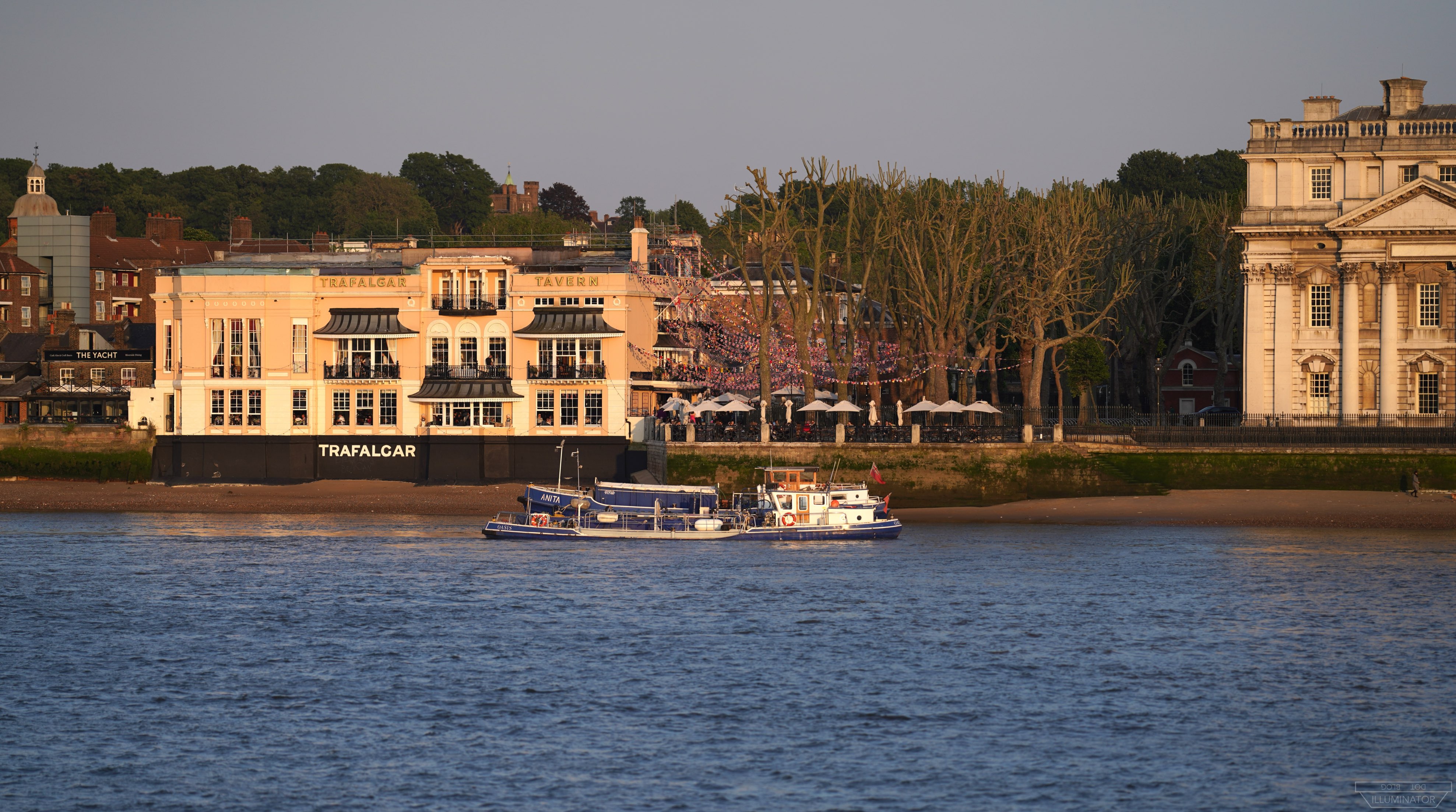
{ The Trafalgar, by Greenwich Hospital (right). Photo by L. Zachary. }
Indeed, my co-author Alison Freebairn has discovered that this idea even predates Greenwich’s current museum. When William Parker Snow first proposed the Franklin Expedition ‘50th anniversary’ commemoration for 1895 – to reunite aging Franklin searchers like himself – he had actually suggested that they do a luncheon at The Trafalgar afterwards (Kentish Mercury, 1894). When the event came to pass, the luncheon was held instead on two steamers on the Thames — and Parker Snow was already buried in his unmarked grave (link to grave photograph). Nonetheless, the idea at least of Franklinists meeting at The Trafalgar can thus be said to stretch back into the Victorian era, and literally from the first generation of Franklin searchers (Snow was on the big 1850 search, and was the first searcher to return Franklin relics home to Britain).
[As we write, The Trafalgar’s riverside seating in the above photograph is under threat of being taken away by the city council as “visual clutter.” Our thanks to Jessica Forde for bringing this story to the Franklin community’s attention. Kevin Paul McKenzie additionally found the BBC’s coverage (link).]
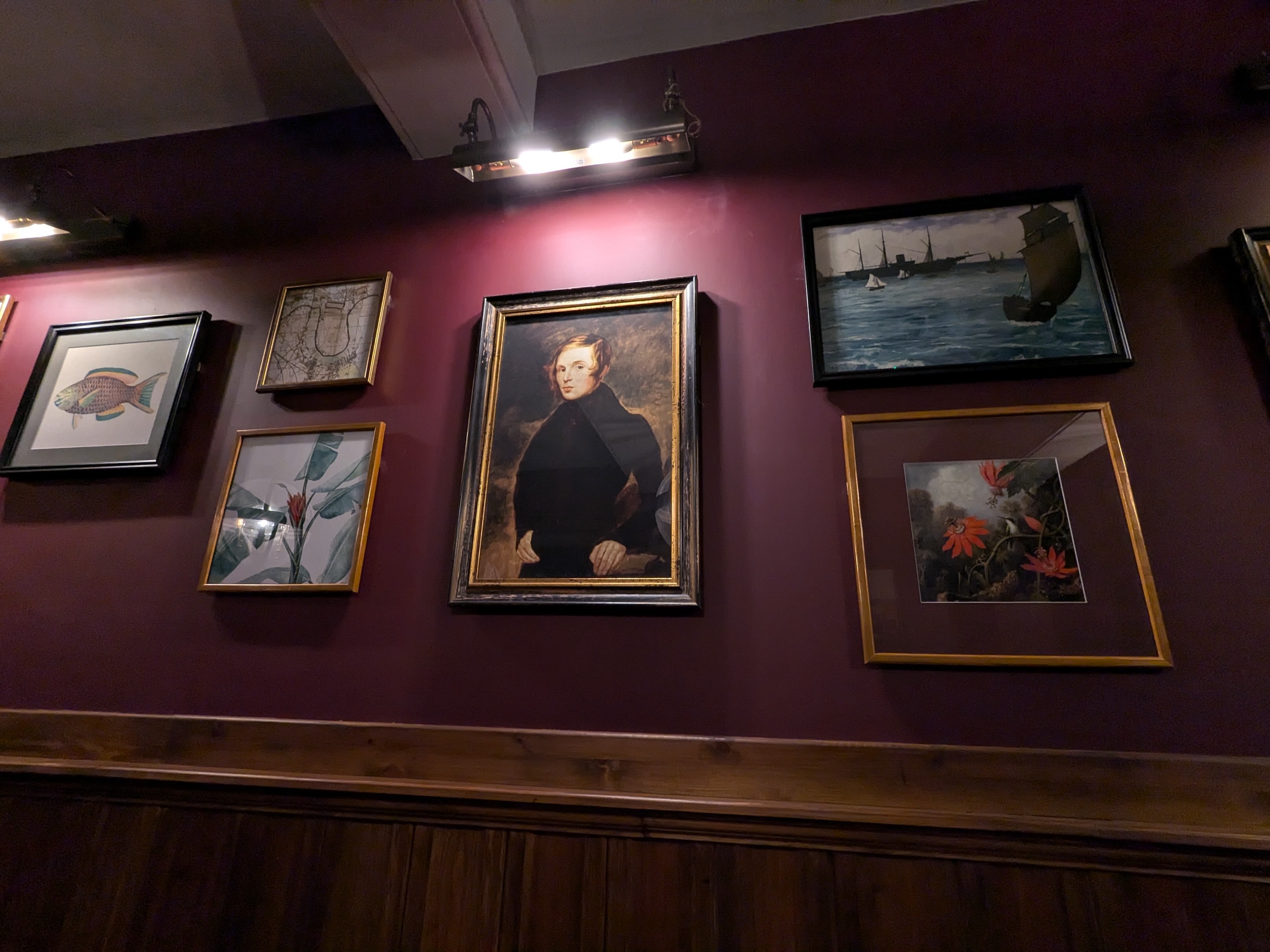
{ The Terror’s assistant surgeon. Photograph by Alex Cross. }
We can also mention The Richard The First pub in Greenwich. Alex Cross from St Helens, Merseyside – who last year changed the provenance of “McClintock’s smock” at the National Maritime Museum away from McClintock (link) – recently found that Greenwich’s Richard The First pub has hung the portrait of Alexander McDonald, Assistant Surgeon on the Terror (link to original at NMM).
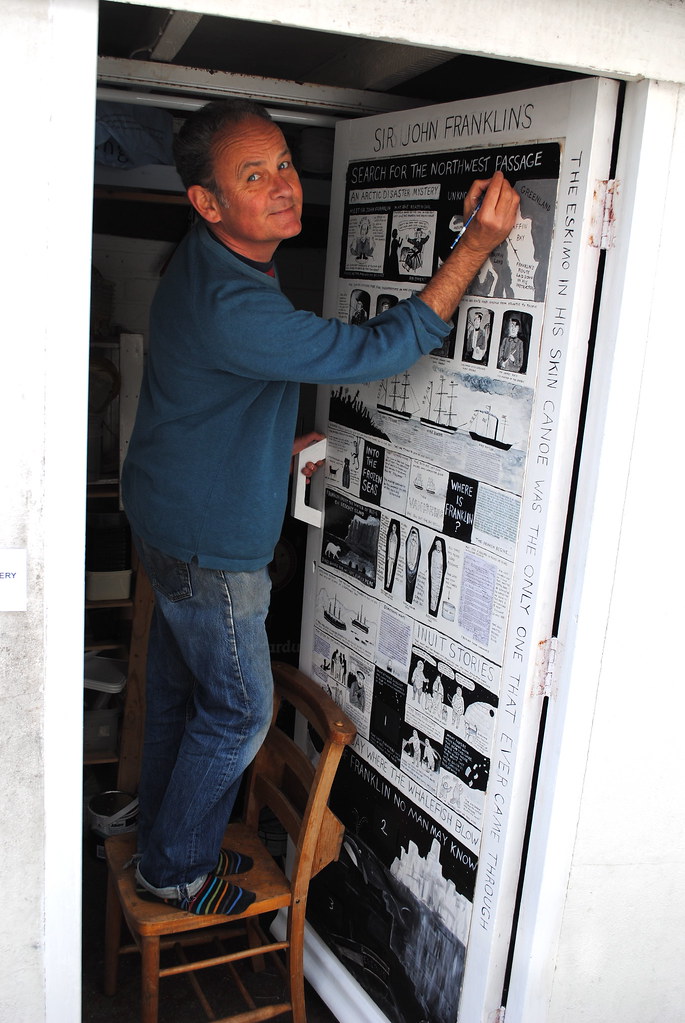
{ Peter Chrisp creating the Franklin door, 2013. }
The unusual Bom-Bane’s cafe in Brighton (link) features a door that tells the story of the expedition (link to video). The artwork was created in 2013 by the writer Peter Chrisp (link), well known in the Franklin Expedition community online as Bongo Pete — and world famous for his Christmas cards with Lisa Wolfe (link).
Returning to the East India Docks: Immediately behind the wreck of The Sir John Franklin pub, across Follett Street, I was intrigued to see the coat of arms of a Cardinal of the Roman Catholic church. The shield is surrounded by the signature tasseled hat of a Cardinal – the galero – several examples of which can be seen hanging above dead Cardinals in London’s Westminster Cathedral (along with much more mosaic work by Tessa Hunkin, the artist who created The Enterprise pub’s mosaic).

{ Cardinal’s coat of arms behind The Sir John Franklin site. }
This coat of arms turned out to be that of Cardinal Thomas Wolsey, who died in 1530. As a foreigner, I learned that its significance here is as a symbol, not of Wolsey, but of Christ Church, Oxford, which still uses Wolsey’s coat of arms. This particular building behind The Sir John Franklin pub was reportedly a Seamen’s Mission, set up by Christ Church as part of their larger St. Frideswide’s Mission complex on this block.
In the 1950s (the era when the old Sir John Franklin pub would be torn down), one of the sisters at St. Frideswide was Jennifer Worth. A half century later, Worth would publish a memoir, Call The Midwife, about her time serving in this community. Her book became the source for the UK’s long-running television series of the same name. Though the community of St. Frideswide’s nuns has moved, their old building (the real “Nonnatus House”) still stands, down around the corner from the wreck of The Sir John Franklin pub.

{ East London in the Call The Midwife credits. }
H.M. Tomlinson (1873-1958) was an English anti-war and travel writer who grew up in this same district of London, known as Poplar (and sometimes as Bromley). In an essay late in life, Tomlinson recalled The Sir John Franklin pub from his youth.
A tavern was not far away, the Sir John Franklin. Who was he? This we were told, and that his ships had sailed from our river to find a passage by the north-west to Asia, and had never come back. We were prompted to peer distantly into the silent region that held the secret of Franklin and his men. One day, father told us, he had seen two musk oxen walk ashore from a ship out of the Arctic, and he described the fabulous creatures, and the white land in which they were found, in grim humour; for Poplar, we had to know, was more pleasantly situated.[From A Mingled Yarn, 1952.]
Tomlinson was born in 1873, whilst his father died in 1886. Therefore, this childhood remembrance is also an early confirmation of the name “Sir John Franklin” being on the pub on East India Dock Road.
A smidge earlier is this article from New Years 1875, which reads like modern social media harassment reimagined with Victorian legal consequences. [Note that “St. Leonard’s Road” is the street at the corner of The Sir John Franklin pub.]
Disgraceful Charge Of Libelling A Young Woman At Bromley.William Blythe and James Prentice, young men, were brought before Mr. Lushington at the Thames Police Court, charged with publishing a false, obscene, and defamatory libel concerning a young woman named Simms, who, at the time of the receipt of the alleged libel, was living with her father, who then kept the Sir John Franklin public-house, St. Leonard’s Road, Bromley.The complainant said that she knew the defendant Prentice as a customer at the Sir John Franklin, and also at another public-house called the Connaught Arms. She saw him on August the 24th, and on the following day she received the letter produced through the post. She also knew Blythe as a customer.Charles Pearl, a pilot, said he knew the defendants. On the 24th August Prentice asked him to walk to the post office with him, and he saw Blythe in the Stainsby-road, Poplar. On the way Blythe asked him to direct a letter, which he declined to do. Blythe gave the letter produced to Prentice, and told him to give it to witness, which he did. He read it, and remarked that the man who wrote it deserved seven years. He returned the letter, and the defendants entered the post-office. When they came out he saw a letter in Blythe’s hand, with the name of Simms, East India-road, on the back of it. Both put a letter in the box.Thomas Walton, a sergeant attached to the court, said he had been looking after Blythe from the 14th of September. On the 24th of December he apprehended him in Poplar, and on reading the warrant to him he made no reply. He served a summons on Prentice specifying the charge, and he made no answer.Blythe made no answer to the charge, but Prentice said he had two witnesses to call, but they were unable to attend through illness.Mr. Lushington said he could call the witnesses at the trial, and committed them both for trial for publishing a libellous letter.[East London Observer, 2 January 1875.]
Appendix 2: The Franklin Expedition pubs of London.
This list is undoubtedly incomplete, as many more must have been lost to history, and a Franklin link to common pub names like “Fox” is hard to prove.
The Sir John Franklin at the East India Docks.
Pubwiki.co.uk: (link).
London Picture Archive, 1920, distant: (link).
London Picture Archive, 1920, distant, with pub flag flying: (link).
London Picture Archive, 1955: (link).
London Picture Archive, 1956, pre-demolition: (link).
London Picture Archive, 1956, closed for demolition: (link).
London Picture Archive, 1956, being razed: (link).
London Picture Archive, 1957, view into cellar: (link).
Camra.org.uk: (link).
Shopfront Elegy: (link).
Dodgy Boozers: (link).
The Sir John Franklin in Greenhithe.
Dover-Kent.com on The White Hart: (link).
Dover-Kent.com on The Sir John Franklin: (link).
Pubwiki.co.uk: (link).
The Sir John Franklin on Narrow Street in Limehouse.
Pubwiki.co.uk: (link).
Pubology.co.uk: (link).
For an early mention, see East London Observer, 1866.
The Sir John Franklin in Shoreditch.
Pubwiki.co.uk: (link).
The Lady Franklin on Old Ford Road in Bow.
London Picture Archive, 1970: (link).
Pubwiki.co.uk: (link).
OurBow.com, photo identifying current site: (link).
The Lady Franklin on Albany Road in Camberwell.
Pubwiki.co.uk: (link).
Photograph on Alamy: (link).
The Enterprise on Three Colt Street in Limehouse.
Peter Marshall photograph from 1990: (link).
Camra.org.uk, with additional photograph from 1988: (link).
Pubwiki.co.uk: (link).
The Enterprise on Red Lion Street.
Official site: the-enterprise.co.uk
Pubwiki.co.uk: (link).
Older photograph: (link).
Exploring-London.com: (link).
The Resolute on Harrow Lane.
Flickr photograph from 2010: (link).
Exterior video from circa 1988: (link).
Purported photograph of the previous building: (link).
Pubwiki.co.uk, with 2006 photograph: (link).
Camra.org.uk, with before/after photos: (link).
And while we can’t prove a connection to the Franklin search ship, London has a North Star pub that is interestingly dated to 1850. [Their pub sign is a polar bear climbing on the star.]
Beyond London, there was a Sir John Franklin pub on London Road in Nottingham (link to photo), known to be operating as early as 1865 (see Nottinghamshire Guardian, 1865). A few sources also suggest there was a Sir John Franklin pub in Great Yarmouth on Nelson Road as early as 1870, until perhaps quite recently.
There were undoubtedly a number of other such Sir John Franklin pubs across the British Isles, though we are unaware of any that have survived. A separate investigation could be made just for Australia.
Bibliography.
Author citations:
Boak & Bailey.
2017. The Changing Scene: Watney’s Pubs of 1964. Boak & Bailey’s Beer Blog, 30 October 2017 (link).
Martland, Bill.
2006 (unverified date). In the Begining There was Theresa.
For testimonials about Bill “Tyke” Martland, see his online wake at Stripping The Illusion (link).
Rich, Barbara.
2000. Out of the Frozen Deep (Part IV - Towards Victory Point 1856–1859). Medium.com, 8 March 2020 (link).
Tomlinson, H.M.
1952. A Mingled Yarn.
Zachary, Logan & Freebairn, Alison.
2021. A Franklin Expedition Guide to London. Illuminator.blog, 14 July 2021 (link).
Zachary, Logan & Freebairn, Alison.
2021. Where The Fox Docked. Illuminator.blog, 4 August 2021 (link).
Newspapers and periodicals (by publication date):
The Building News.
1859, January 21. Page 72, column 2, “Poplar.”
“For rebuilding house the corner of Saint Leonard’s-road and East India-road, Poplar, for Mr. Francis Rogers. Mr. James Harrison, architect...”
The Morning Advertiser.
1859, August 12. Page 7, column 4.
Early mention of The Resolute pub.
Evening Star And Dial.
1861, February 4. Page 4, column 4, “Thames.”
Another early mention of The Resolute pub (a glass window vandalized).
The Evening Standard (London).
1863, January 23. Page 7, column 5, “THAMES. The Adventures of a Gold Watch.”
The Nottinghamshire Guardian.
1865, July 7. Page 3, column 3.
East London Observer.
1865, September 23. Page 2, column 6, “Serious Accident at the River Dock, Shadwell.”
Early mention of what is apparently The Sir John Franklin pub in Limehouse.
East London Observer.
1866, March 3. Page 3, column 2, “Widening of Narrow-Street” (link to BNA).
Early mention of The Sir John Franklin pub on Narrow Street in Limehouse: in fact a suggestion for its “removal” already in 1866.
London Daily Chronicle And Clerkenwell News.
1872, March 14. Page 5, column 5, “THAMES. Sanguinary Affray.”
A “disturbance and riot” at The Sir John Franklin. “He [the police constable] was unable to recognize either of the three women at the time, as their faces and hands were covered with blood, and the front of the bar was one pool of blood.” When the police constable tries to stop the fight, he ends up a part of it.
The East End News.
1872, October 4. Page 1, column 6, “Notice of Removal. British Admiral “Poplar” Loan Office.”
“NOTICE OF REMOVAL. BRITISH ADMIRAL “POPLAR” LOAN OFFICE, recently held at the Sir John Franklin, corner of St. Leonard’s Road, East India Road, is now REMOVED to the BRITISH ADMIRAL, directly opposite Poplar Church, where the Proprietors are prepared to make advances upon personal and available security in any Sum from £2 to £500. Forms, containing full information, to be had at the Bar at any time, price 2d. each.—Established 1844.”
East London Observer.
1875, January 2. Page 3, column 4, “Disgraceful Charge Of Libelling A Young Woman At Bromley.”
A full transcription is in Appendix 1.
Kentish Mercury.
1894, November 30. Page 3, column 6, “An Arctic Commemoration.”
I believe Snow sent the same appeal to several other newspapers as well.
The Red Barrel.
1964, April.
Miscellaneous and photography sources:
For the photography from The London Picture Archive:
Photo of The Sir John Franklin being razed in 1956: #343959 (link).
Photo of The Sir John Franklin still open in 1955: #109432 (link).
Photo of The Lady Franklin building after closure: #326128 (link).
Our thanks to Boak & Bailey for letting us use their rare image of The Sir John Franklin pub interior that they found (link).
The Lady Franklin tankard was sold on 11 November 2021 by Beeston Auctions of Norfolk, Lot 1116 (link).
The historic image showing both the East India Docks entrance and Blackwall Tunnel entrance is from an old postcard I own.
The two photographs of the fox at the docks were taken by myself with a Sony A7R III and a 35mm F1.4 GM lens. The photograph of The Trafalgar was taken from across the river with a 135mm F1.8 GM lens. Everything else, Alison and I took with purple iPhone 14 Pros.
